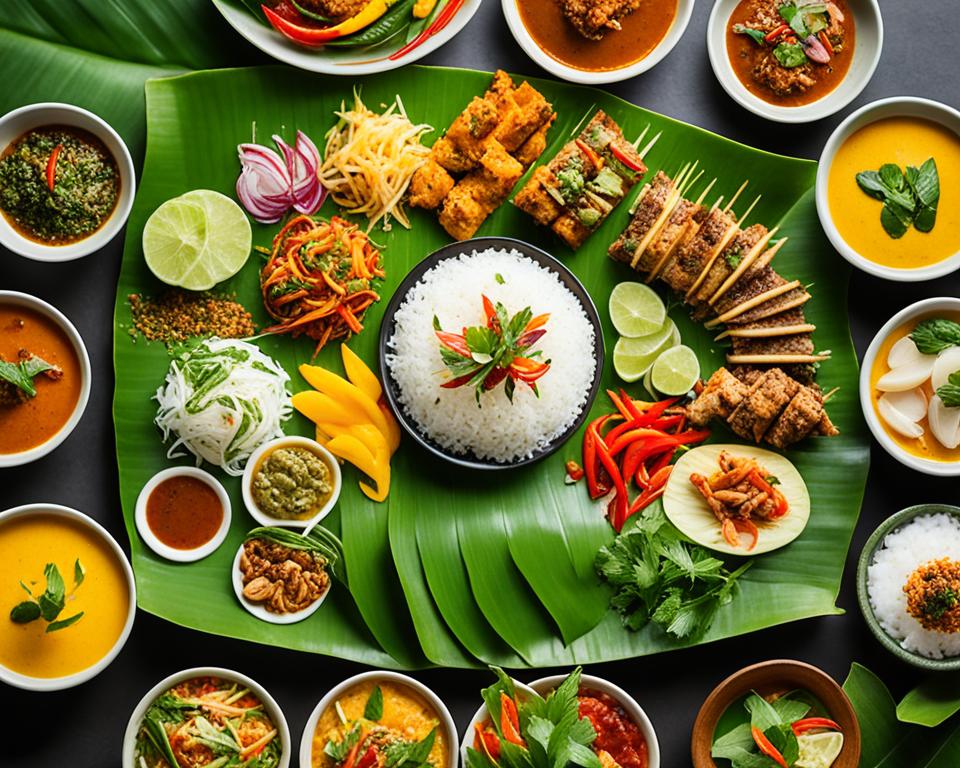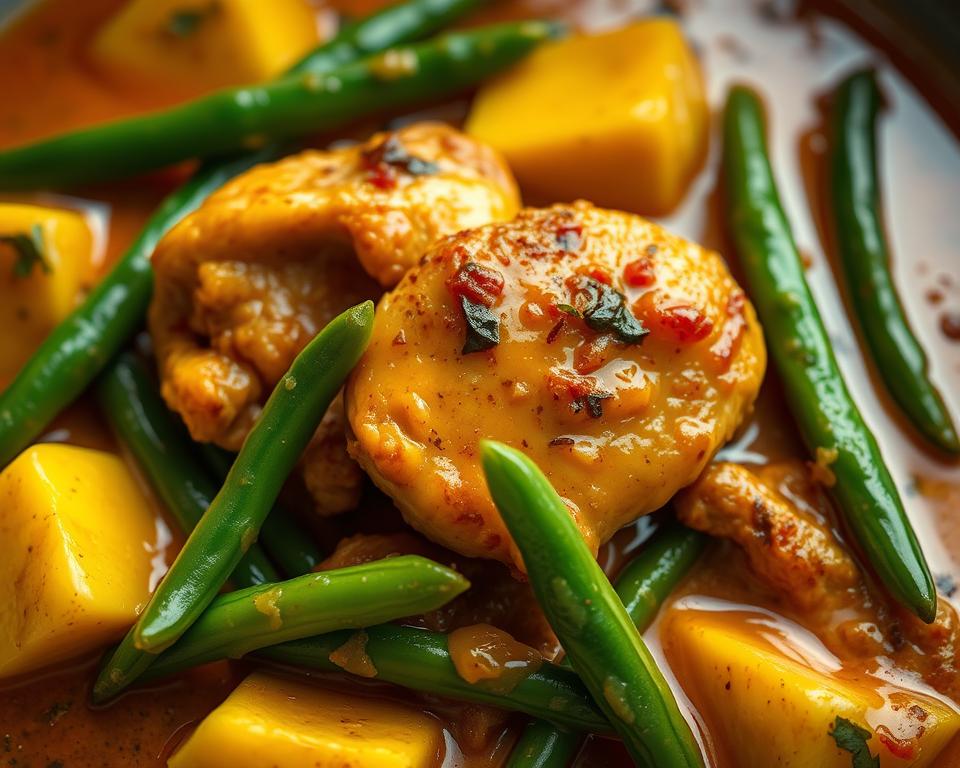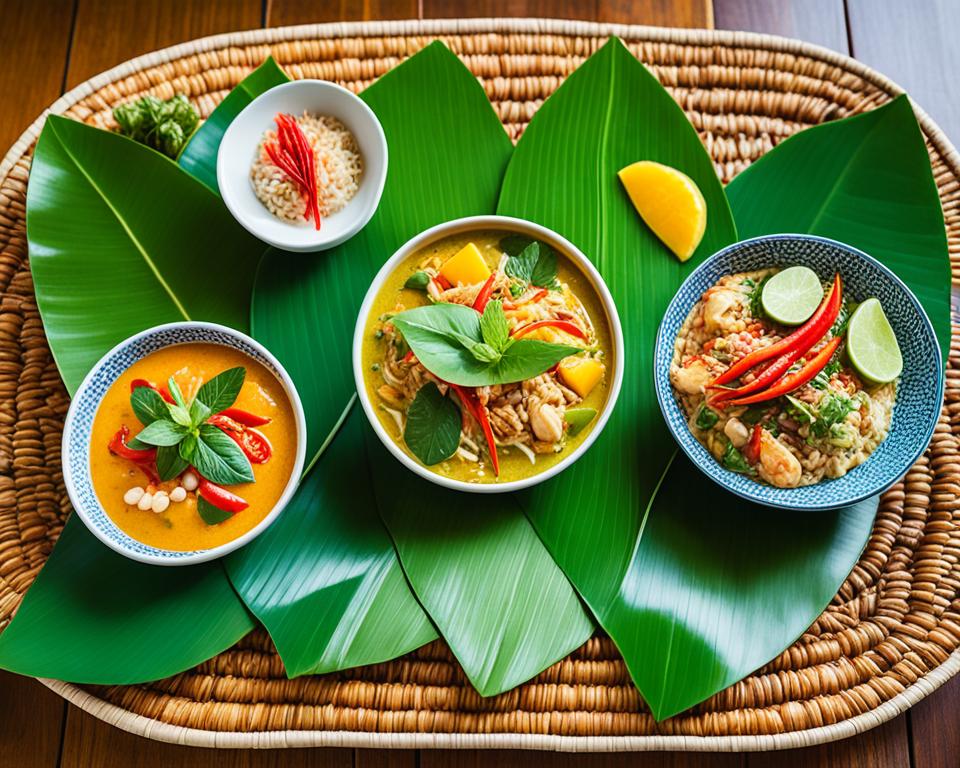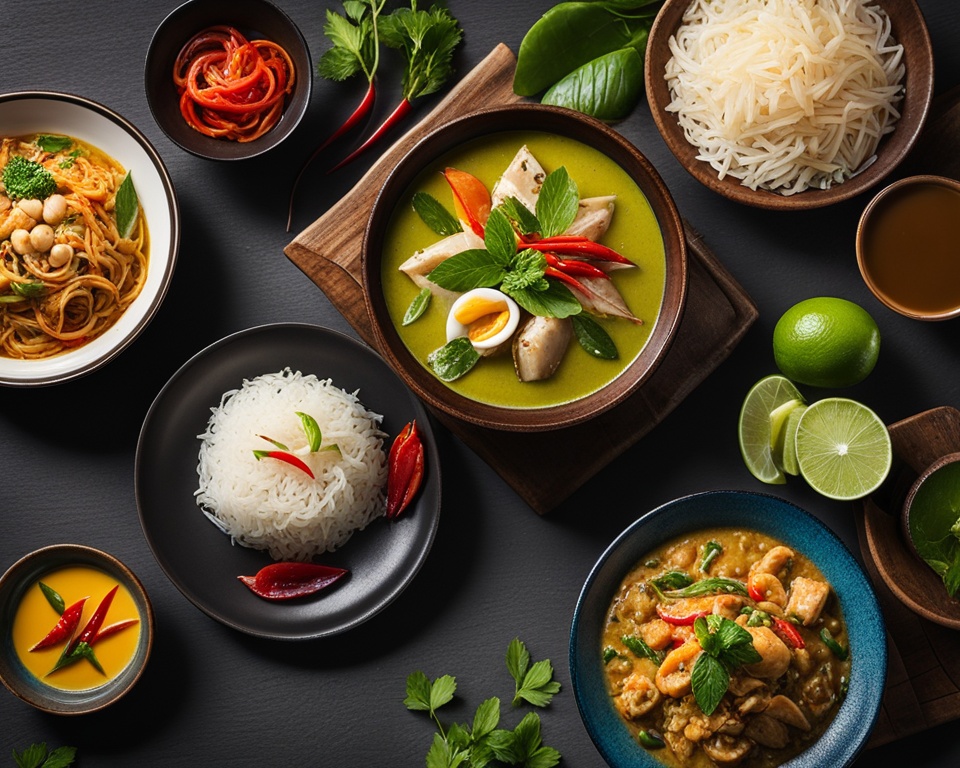Embark on a captivating journey through the diverse and flavorful world of Thai cuisine. From iconic curries and noodle dishes to mouthwatering street food delights, you’ll discover the vibrant tapestry of flavors that define what Thai people eat. We’ll explore the historical influences, regional variations, and staple ingredients that shape Thai cooking, uncovering the secrets behind the perfect balance of sweet, sour, salty, and spicy. Get ready to tantalize your taste buds and deepen your appreciation for the rich culinary traditions of Thailand.
Thai Food Culture: A Vibrant Tapestry of Flavors
Thai cuisine is a reflection of the country’s rich cultural heritage, shaped by a tapestry of historical influences and regional diversity. The culinary traditions of Thailand have been molded by the interplay of Chinese, Indian, Malay, and other Southeast Asian culinary traditions, resulting in a unique and delightful fusion of thai food culture and flavors.
Historical Influences on Thai Cuisine
Throughout its history, Thai cuisine has been influenced by a variety of cultural and trade exchanges. The introduction of ingredients and cooking techniques from neighboring regions, such as China, India, and Malaysia, have all contributed to the distinct flavors and preparations that define historical influences on thai cuisine. This cross-cultural exchange has led to the creation of iconic Thai dishes that seamlessly blend diverse culinary traditions.
Regional Variations and Specialties
Each region of Thailand is known for its own unique regional thai cuisines and regional thai specialties. From the fiery curries of the north to the fragrant, coconut-based dishes of the south, the country’s diverse geography and cultural influences have given rise to a rich tapestry of regional culinary traditions. Exploring these regional variations offers a deeper understanding and appreciation of the complexity and depth of Thai cuisine.
Staple Ingredients in Thai Cooking
At the heart of Thai cuisine lies a vibrant array of ingredients that lend their distinct flavors and aromas to the country’s beloved dishes. From the fragrant lemongrass and kaffir lime leaves to the fiery chili peppers and aromatic galangal, these Thai herbs and spices form the foundation of Thai cooking. These flavorful elements work in harmony to create the signature balance of sweet, sour, salty, and spicy that defines the captivating taste of Thai cuisine.
The Essential Thai Herbs and Spices
Thai cooking revolves around a carefully curated selection of Thai herbs and spices that impart depth and complexity to the dishes. Lemongrass, with its citrusy and slightly sweet profile, is a ubiquitous ingredient in curries, soups, and stir-fries. Kaffir lime leaves, with their distinct aroma and bitterness, lend a fragrant touch to many Thai dishes. Galangal, a close relative of ginger, contributes a warm, peppery flavor, while fresh chili peppers add the signature fiery kick that Thai cuisine is renowned for.
Versatile Sauces and Condiments
Alongside the aromatic Thai herbs and spices, Thai sauces and condiments play a crucial role in shaping the flavor profile of Thai dishes. Fish sauce, a staple ingredient in many Thai recipes, offers a savory, umami-rich base that balances the sweet, sour, and spicy notes. Soy sauce, both light and dark varieties, lends depth and complexity to marinades, dipping sauces, and stir-fries. An array of pastes, such as red curry paste, green curry paste, and shrimp paste, deliver concentrated flavors that can transform a simple dish into a culinary masterpiece.
| Thai Herbs and Spices | Thai Sauces and Condiments |
|---|---|
| Lemongrass | Fish Sauce |
| Kaffir Lime Leaves | Soy Sauce (Light and Dark) |
| Galangal | Red Curry Paste |
| Chili Peppers | Green Curry Paste |
| Turmeric | Shrimp Paste |
Iconic Thai Dishes You Must Try
Thai cuisine boasts a rich repertoire of iconic and beloved dishes that have captivated food enthusiasts worldwide. From the tantalizing Tom Yum Goong, a spicy and sour shrimp soup, to the quintessential Pad Thai, a delectable noodle dish, these culinary gems showcase the depth and complexity of Thai flavors.
Tom Yum Goong: The Beloved Spicy Shrimp Soup
The iconic Tom Yum Goong is a Thai staple that has gained global recognition for its unique blend of flavors. This spicy and sour shrimp soup is characterized by the harmonious interplay of lemongrass, kaffir lime leaves, galangal, fish sauce, and fresh shrimp. The complex balance of sweet, sour, and fiery elements creates a symphony of tastes that tantalizes the palate and warms the soul.
Pad Thai: The National Noodle Dish
As the quintessential Pad Thai, this beloved noodle dish has become a symbol of Thai cuisine. Featuring rice noodles stir-fried with shrimp, eggs, bean sprouts, and a savory-sweet sauce, Pad Thai showcases the country’s culinary versatility. From its humble street food origins to its global popularity, this iconic dish represents the vibrant and dynamic nature of Thai food culture.
Thai Street Food: A Culinary Adventure
Exploring the vibrant Thai street food scene is an integral part of experiencing the true essence of Thai cuisine. From bustling night markets to roadside stalls, Thai street food offers a tantalizing array of delicacies that showcase the country’s culinary creativity and diversity. In this section, we’ll introduce you to some of the most popular and iconic Thai street food specialties, ranging from savory skewered meats and sizzling noodle dishes to sweet and refreshing tropical fruit delights. Immerse yourself in the lively atmosphere and tantalizing aromas of Thailand’s thriving street food culture.
Popular Thai Street Food Delicacies
From the sizzling pad thai noodles to the savory som tam (papaya salad), Thai street food is a testament to the country’s culinary ingenuity. Indulge in the rich, fragrant flavors of khao niaow ma muang (sticky rice with mango), or savor the smoky char of moo ping (grilled pork skewers). Explore the vibrant Thai street food scene and discover a world of unexpected delights that will tantalize your taste buds.
What Thai People Eat: A Typical Thai Meal
To truly understand the culinary landscape of Thailand, it’s essential to explore the traditions and customs that shape a typical Thai meal. From the beloved breakfast favorites to the intricate lunch and dinner rituals, Thai cuisine encompasses a diverse array of dishes and dining experiences that are deeply rooted in the country’s rich cultural heritage.
Breakfast Favorites in Thailand
As the sun rises, Thai people often start their day with a selection of flavorful and nourishing breakfast options. One of the most popular choices is Jok, a savory rice porridge that can be dressed up with various toppings such as minced pork, century eggs, and crispy fried dough. Another classic is Khao Niaow Ma Muang, the iconic sticky rice with fresh, juicy mango, often served with a sweet, creamy coconut sauce. These breakfast staples not only provide sustenance but also offer a glimpse into the diverse culinary traditions that Thai people cherish.
Lunch and Dinner Traditions
As the day progresses, Thai meals become more elaborate and communal. Lunch and dinner typically feature a variety of dishes served simultaneously, allowing for a harmonious interplay of flavors and textures. At the heart of these meals are staple dishes like Khao Niaow Ma Muang (coconut rice), Tom Yum Goong (spicy shrimp soup), and Pad Thai (stir-fried noodles). These dishes are often accompanied by an array of curries, salads, and vegetable-based side dishes, all designed to create a balanced and satisfying dining experience.
The communal nature of Thai meals is also a significant aspect of the dining culture. Families and friends often gather around the table, sharing dishes and engaging in lively conversations, fostering a sense of togetherness and connection that is fundamental to Thai social customs.
By exploring the breakfast favorites and the intricate lunch and dinner traditions of Thai cuisine, we gain a deeper understanding of what Thai people eat and the cultural significance that shapes their culinary experiences. From the comforting rice porridge to the vibrant and balanced multi-course meals, the rhythms and rituals of a typical Thai meal offer a captivating glimpse into the heart and soul of this vibrant food culture.
The Art of Thai Cooking
Thai cuisine is renowned for its masterful balance of flavors, seamlessly blending the elements of sweet, sour, salty, and spicy to create a harmonious and captivating dining experience. This delicate interplay of tastes is the hallmark of Thai cooking, and it is what sets it apart from other culinary traditions.
Balancing Flavors: Sweet, Sour, Salty, and Spicy
In this section, we’ll explore the art of achieving this perfect flavor balance, examining the techniques and principles that Thai chefs and home cooks employ to craft their signature dishes. Understanding this fundamental aspect of Thai cuisine will deepen your appreciation for the complexity and sophistication of this beloved food culture.
At the heart of Thai flavor balancing is the skillful combination of the four primary tastes: sweet, sour, salty, and spicy. Thai cooks meticulously adjust the proportions of these elements to create a harmonious and captivating flavor profile in each dish. This harmonious balance is what distinguishes Thai cuisine and makes it so alluring to the palate.
From the fragrant and creamy curries to the tangy and refreshing salads, every Thai dish is a delicate dance of flavors, with each ingredient playing a crucial role in the overall symphony of tastes. By understanding the principles of Thai flavor balancing, you’ll unlock the secrets to creating authentic and delectable Thai dishes in your own kitchen.
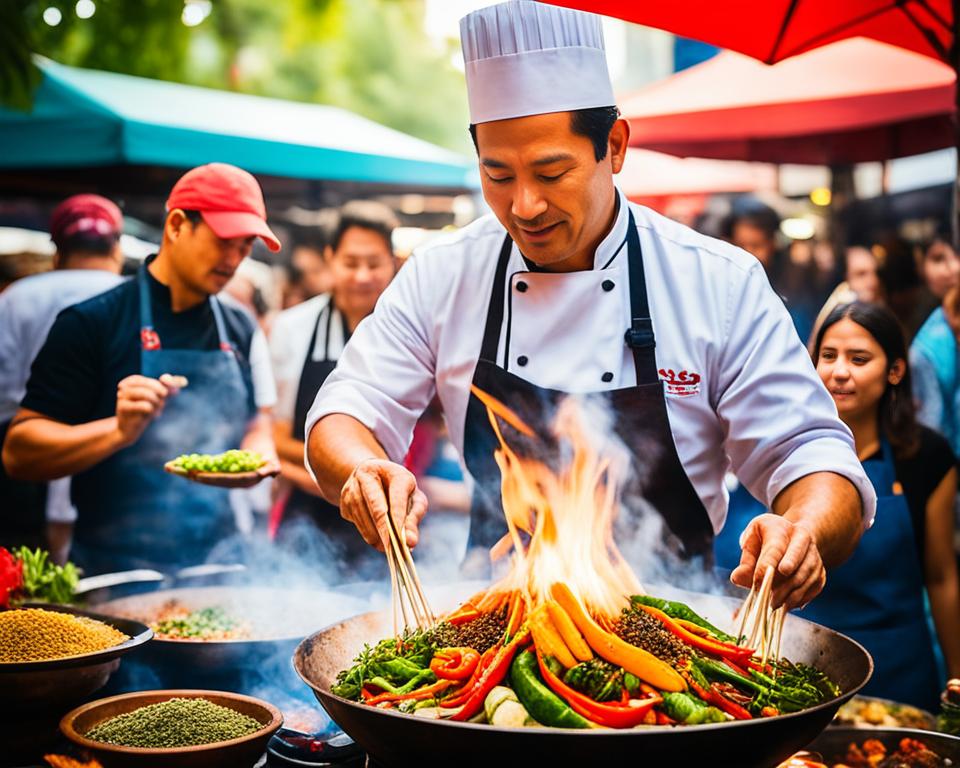
Thai Dietary Habits and Beliefs
Thai cuisine is not merely a celebration of flavors, but also a reflection of the country’s rich cultural beliefs and dietary habits. At the heart of Thai culinary practices lies a profound reverence for fresh, locally sourced ingredients and an emphasis on balance and moderation. These principles are deeply rooted in Thailand’s history, religion, and social customs, shaping the way Thai people approach their food.
One of the defining characteristics of Thai dietary habits is the importance placed on sourcing ingredients from nearby, sustainable sources. Thai people often prioritize the use of fresh, seasonal produce, seafood, and protein, believing that these locally grown and harvested items not only offer superior taste and nutrition but also embody a connection to the land and its traditions.
Similarly, the concept of Thai culinary beliefs is heavily influenced by Buddhist teachings, which emphasize the importance of balance and harmony. Thai dishes are typically designed to achieve a harmonious blend of the four fundamental tastes: sweet, sour, salty, and spicy. This delicate balance is not only pleasing to the palate but also believed to promote overall well-being and balance within the body.
Beyond the culinary realm, Thai dietary habits and beliefs are also shaped by the country’s rich agricultural heritage and the reverence for the natural world. Thai people often incorporate a diverse array of herbs, spices, and fermented ingredients into their dishes, believing that these elements possess medicinal properties and can contribute to physical and spiritual well-being.
By understanding the deep-rooted Thai dietary habits and Thai culinary beliefs that underpin the country’s cuisine, we can gain a richer appreciation for the profound connection between food, culture, and the natural world that defines the essence of Thai gastronomy.
Vegetarian and Vegan Options in Thai Cuisine
Thai cuisine, renowned for its vibrant flavors and diverse ingredients, offers a wealth of vegetarian and vegan options that cater to a wide range of dietary preferences and beliefs. From the ubiquitous Massaman curry to the fragrant Som Tam salad, the plant-based thai food of Thailand showcases the remarkable versatility and creativity of this celebrated culinary tradition.
Exploring Plant-based Thai Dishes
Thai chefs and home cooks have long embraced the use of fresh, locally sourced ingredients, making it easier to adapt many classic Thai dishes to vegetarian thai cuisine and vegan thai dishes. Dishes like Pad Krapow Mushroom, a stir-fried mushroom dish with holy basil, and Khao Niaow Ma Muang, a mouthwatering mango sticky rice dessert, prove that vegetarian and vegan diners can indulge in the same vibrant and satisfying flavors as their meat-eating counterparts.
Exploring the diverse array of plant-based thai food options allows diners to experience the full breadth of Thai culinary creativity. From the hearty and comforting Pumpkin Curry to the refreshing and zesty Papaya Salad, these vegetarian and vegan Thai specialties showcase the unique preparation methods and flavor profiles that have made Thai cuisine a beloved global favorite.
| Vegetarian Thai Dish | Key Ingredients | Flavor Profile |
|---|---|---|
| Massaman Curry | Coconut milk, potatoes, onions, peanuts | Rich, creamy, and mildly spiced |
| Tom Kha Tofu | Tofu, coconut milk, galangal, lemongrass | Fragrant, tangy, and slightly spicy |
| Pad Thai (with rice noodles) | Rice noodles, bean sprouts, peanuts, lime | Salty, sweet, and slightly sour |
| Som Tam | Shredded green papaya, tomatoes, peanuts | Refreshing, spicy, and tangy |
As you explore the vibrant culinary landscape of Thailand, be sure to seek out these delectable vegetarian thai cuisine and vegan thai dishes that showcase the versatility and creativity of this beloved food culture.
Authentic Thai Recipes to Try at Home
Eager to bring the vibrant flavors of Thailand into your own kitchen? This section provides a curated selection of authentic thai recipes that you can easily recreate at home. From the aromatic and creamy thai curries to the refreshing and zesty thai salads and appetizers, these dishes offer a gateway to exploring the depth and nuance of Thai cuisine. With detailed instructions and insights into the traditional techniques, you’ll be able to transport your taste buds to the bustling streets and lush landscapes of Thailand.
Classic Thai Curries
Thai curries are renowned for their rich, complex flavors and ability to warm the soul. Dive into the world of authentic thai recipes and master the art of creating iconic dishes like Massaman Curry, Red Curry, and Green Curry. Each curry boasts its own unique blend of spices, herbs, and aromatics, resulting in a harmonious balance of sweet, sour, salty, and spicy notes. With step-by-step guidance, you’ll learn the secrets to preparing these beloved thai curries in your own kitchen.
Flavorful Thai Salads and Appetizers
Alongside the renowned thai curries, the vibrant world of authentic thai recipes also showcases an array of delectable thai salads and appetizers. Explore the refreshing and zesty flavors of Som Tam (Papaya Salad), Larb (Minced Meat Salad), and Moo Ping (Grilled Pork Skewers). These dishes not only tantalize the taste buds but also celebrate the use of fresh, locally sourced ingredients that are central to Thai culinary traditions. Dive into these authentic thai recipes and elevate your home-cooked meals with the flavors of Thailand.
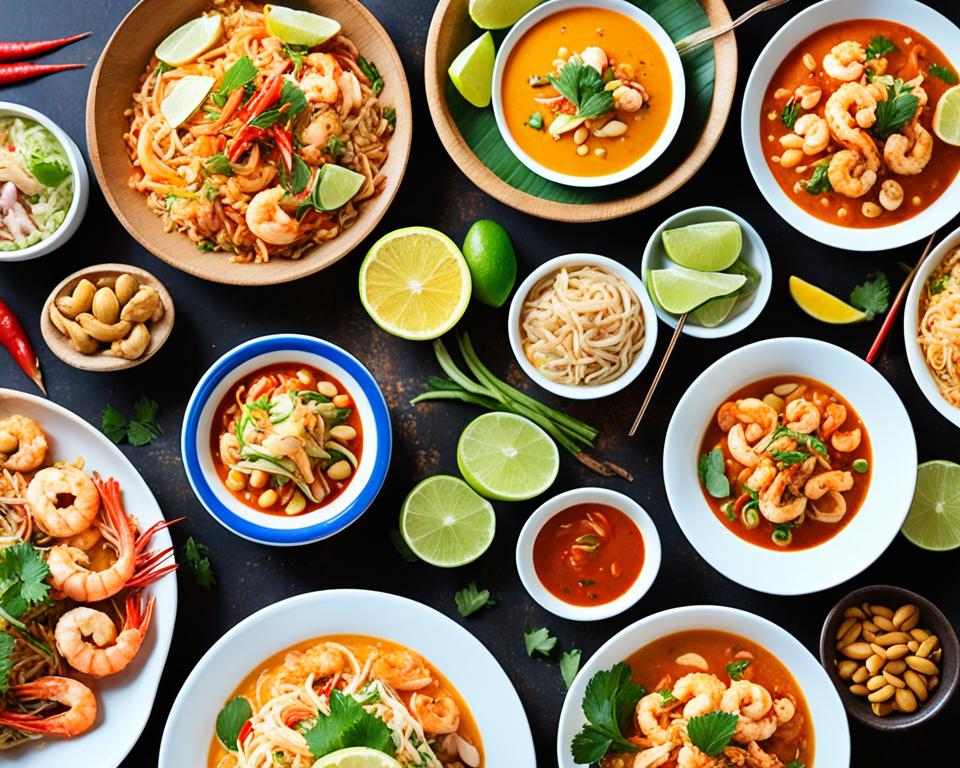
The Influence of Thai Cuisine Worldwide
The captivating flavors and distinctive culinary traditions of Thailand have made a lasting impact on the global food landscape. Thai restaurants have sprung up in cities around the world, introducing diverse audiences to the richness and complexity of this beloved cuisine. From the proliferation of Thai eateries to the growing popularity of Thai-inspired dishes, the far-reaching influence of Thailand’s culinary legacy is undeniable.
As Thai cuisine has gained recognition for its vibrant flavors and unique blend of sweet, sour, salty, and spicy elements, it has inspired culinary innovations across the globe. Thai restaurants have become a staple in major metropolitan areas, catering to the insatiable demand for authentic and innovative Thai-influenced dishes. These eateries have not only introduced new ingredients and flavor profiles to international palates but have also fostered a deeper appreciation for the artistry and diversity of Thai cuisine.
The global influence of Thai cuisine extends beyond the walls of Thai restaurants worldwide. The popularity of Thai-inspired dishes has transcended geographic boundaries, with elements of Thai cooking being incorporated into fusion cuisines and innovative culinary creations. From the integration of lemongrass, kaffir lime, and coconut milk into international recipes to the widespread adoption of staple Thai ingredients like fish sauce and curry pastes, the impact of Thailand’s culinary heritage is undeniable.
As Thai cuisine continues to captivate and inspire food enthusiasts around the world, it serves as a testament to the enduring power of cultural exchange and the transformative potential of shared culinary experiences. The global success of Thai restaurants and the proliferation of Thai-inspired dishes speak to the universal appeal of this vibrant and flavorful cuisine, solidifying its place as a beloved and influential force in the world of gastronomy.
Experiencing Thai Food in Thailand
For the ultimate Thai culinary adventure, there’s no better place than Thailand itself. Immersing yourself in the country’s vibrant food culture offers a truly authentic and unforgettable experience. In this section, we’ll explore the joys of experiencing Thai food in Thailand, from visiting lively local markets and bustling street stalls to indulging in captivating culinary tours and hands-on cooking classes.
Visiting Local Markets and Street Stalls
Navigating the Thai markets and street stalls is a sensory delight that transports you straight to the heart of Thailand’s culinary traditions. Wander through the vibrant aisles of local markets, where you’ll witness the preparation of beloved dishes and sample the freshest, most flavorful ingredients. From fragrant herbs and spices to gleaming tropical fruits, these bustling hubs offer a glimpse into the daily lives and culinary practices of the Thai people.
Culinary Tours and Cooking Classes
To truly immerse yourself in the art of Thai cuisine, consider embarking on Thai culinary tours and cooking classes. These enriching experiences allow you to delve deeper into the flavors, techniques, and cultural significance of Thai cooking. Under the guidance of expert chefs and local food enthusiasts, you’ll have the opportunity to learn the secrets behind iconic dishes, uncover regional variations, and hone your own culinary skills. Prepare to be inspired as you discover the true essence of Thailand’s vibrant food culture.
Thai Cuisine and Health Benefits
Beyond its captivating flavors, Thai cuisine is renowned for its potential health benefits. The use of fresh, locally sourced ingredients, along with the balanced interplay of sweet, sour, salty, and spicy elements, contribute to the overall nutritional value of Thai dishes. Exploring the health-promoting properties of Thai ingredients can provide valuable insights into how the vibrant and flavorful world of Thai cuisine can nourish both your taste buds and your overall well-being.
Nutritional Value of Thai Ingredients
The foundation of Thai cuisine is built upon a diverse array of herbs, spices, and produce that offer a wealth of health benefits. For instance, the anti-inflammatory properties of turmeric, a staple in Thai curries, have been widely recognized for their potential to alleviate various health conditions. Furthermore, the antioxidant-rich Thai herbs and spices, such as lemongrass, kaffir lime, and galangal, can help support immune function and overall wellness. Even the fermented sauces and condiments commonly used in Thai cooking, like fish sauce and soy sauce, can contribute to improved digestion due to their probiotic properties.
By incorporating these nutrient-dense ingredients into their dishes, Thai cooks have created a cuisine that not only delights the senses but also nourishes the body. Whether you’re enjoying a fragrant Tom Kha Gai (coconut milk soup) or savoring a vibrant Som Tam (papaya salad), you can take comfort in the knowledge that you’re indulging in a culinary experience that offers both flavor and potential health benefits.
